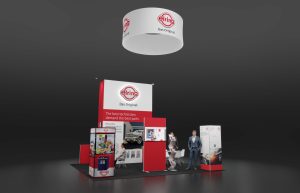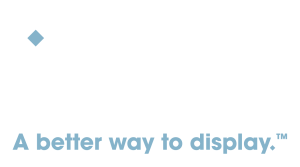What is a peninsula booth, and why would I want one?
A peninsula booth is a type of trade show booth that is open to the aisles on three sides. The fourth side, typically the back of the booth, is adjacent to another booth, forming a “peninsula” effect. A peninsula is usually 20ft by 20ft or larger.
A peninsula booth can have two layout options:
- It can share its back wall with two inline booths (considered a true “peninsula” space)
- It can share its back wall with another peninsula booth (typically called a split island booth)
Peninsula and split island spaces allow for high visibility and foot traffic from multiple directions. Unlike an inline space where attendees enter the booth from one side, peninsulas and split islands allow foot traffic from three sides.
While the goal of an exhibitor is to attract trade show attendees coming toward the booth from any direction, it can be expensive to purchase an island space, which is open to aisles on all four sides. Peninsula and split islands can provide the physical size of an island booth with a smaller price tag.
Below is an example of a peninsula booth we created for a client in the past. Notice how the sides of the back wall are lower?

Are there any display regulations for a peninsula or split island booth?
While similar, peninsula spaces and split islands differ slightly with their booth regulations.
Peninsulas:
- When a peninsula booth is adjacent to two linear booths, the backwall can only go up to four feet high within five feet of each aisle. This rule ensures there is an adequate line of sight for the adjoining linear booths.
- The typical maximum height allowance is 16-20 feet, including signage for the center portion of the backwall.
- Double-sided signage, logos, and graphics must be ten feet away from adjacent booths. Be a good neighbor!
- Unlike inline spaces, peninsula spaces allow hanging signs and graphics as long as they comply with the rules above.
Split Islands:
- Most trade shows allow exhibitors to use the Cubic Content rule in split island spaces, meaning the entire cubic content of the booth may be used up to the maximum allowable height, without any backwall line of sight restrictions.
- The typical maximum height allowance is 16-20 feet.
- Double-sided signage, logos, and graphics must be set back ten feet from adjacent booths. Be a good neighbor!
- Unlike inline spaces, peninsula spaces allow hanging signs and graphics as long as they comply with the rules above.
Feeling overwhelmed?
While these are the standard rules defined by the IAEE, it is critical to confirm the requirements set for your specific event.
Perfecting your display while following the rules may seem a little daunting, but OnePoint is here to help! Our team can help confirm booth regulations for your event and provide suggestions to help you maximize your branding and the customer experience.
Contact us today for more information!



